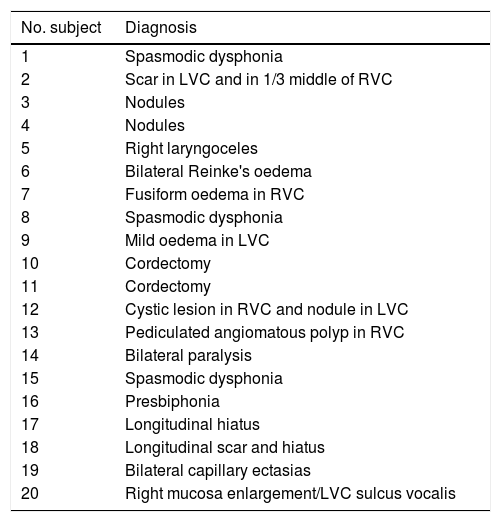In recent years, the use of cepstral measures for acoustic evaluation of voice has increased. One of the most investigated parameters is smoothed cepstral peak prominence (CPPs). The objectives of this paper are to establish the usefulness of this acoustic measure in the objective evaluation of alterations of the voice in Spanish and to determine what type of voice sample (sustained vowels or connected speech) is the most sensitive in evaluating the severity of dysphonia.
MethodForty subjects participated in this study 40, 20 controls and 20 with dysphonia. Two voice samples were recorded for each subject (one sustained vowel/a/and four phonetically balanced sentences) and the CPPs was calculated using the Praat programme. Three raters perceptually evaluated the voice sample with the Grade parameter of GRABS scale.
ResultsSignificantly lower values were found in the dysphonic voices, both for/a/(t[38]=4.85, P<.000) and for phrases (t[38]=5.75, P<.000). In relation to the type of voice sample most suitable for evaluating the severity of voice alterations, a strong correlation was found with the acoustic-perceptual scale of CPPs calculated from connected speech (rs=−0.73) and moderate correlation with that calculated from the sustained vowel (rs=−0.56).
ConclusionThe results of this preliminary study suggest that CPPs is a good measure to detect dysphonia and to objectively assess the severity of alterations in the voice.
En los últimos años se ha incrementado el uso de medidas cepstrales para la evaluación acústica de la voz. Uno de los parámetros más investigados es la prominencia del pico cepstral suavizado (CPPs). Los objetivos de este trabajo son conocer la utilidad de esta medida acústica en la evaluación objetiva de las alteraciones de la voz en español y determinar qué tipo de muestra de voz (vocales sostenidas o habla conectada) es la más sensible para evaluar la severidad de la disfonía.
MétodoEn este estudio participaron 40 sujetos, 20 normofónicos y 20 con disfonía. Se grabaron 2 muestras de voz para cada sujeto (una/a/sostenida y 4 frases fonéticamente balanceadas) y se calculó la CPPs con el programa Praat. Tres expertos valoraron perceptivamente la voz de la muestra con el parámetro grado de la escala GRABS.
ResultadosSe encontraron valores significativamente menores en las voces disfónicas, tanto para la/a/(t[38] = 4.85, p < 0,000) como para las frases (t[38] = 5.75, p < 0,000). En relación con el tipo de muestra de voz más indicado para evaluar la severidad de las alteraciones de la voz se encontró una fuerte correlación con la escala acústico-perceptiva de la CPPs calculada a partir del habla conectada (rs = –0,73) y moderada con la calculada a partir de la vocal sostenida (rs = –0,56).
ConclusiónLos resultados de este estudio preliminar apuntan a que la CPPs es una buena medida para detectar la disfonía y para evaluar objetivamente el grado de severidad de las alteraciones en la voz.











